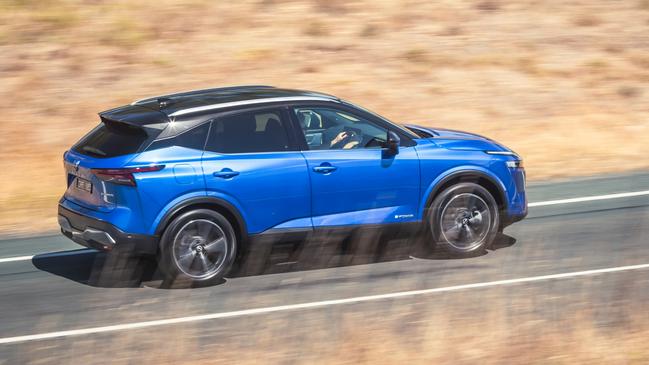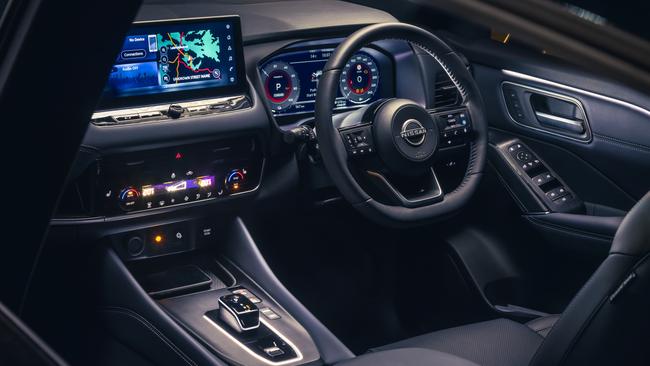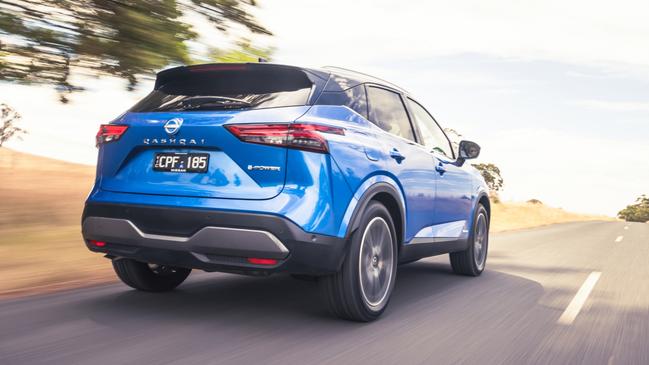Nissan Qashqai Ti e-Power review reveals value is in the complete package
Hybrid technology has now expanded to Nissan’s Qashqai Ti premium compact SUV

Business
Don't miss out on the headlines from Business. Followed categories will be added to My News.
Debate continues to rage surrounding proposed pollution caps.
Labor has relented on its initial plan, yet where the New Vehicle Efficiency Standard rules land look likely to rest with the Coalition and the Greens and we may well see it face a Senate inquiry.
Critics of the standard say it’s heavily skewed toward electric manufacturers. For a company like Nissan, it’s currently hedging bets.
While there’s the petrol-slurping V8 Patrol at one end of the spectrum, at the other is the full electric Leaf with grand plans for more to follow.
Last week Nissan announced The Arc road map as it aims to bridge the gap to 2030, and electrification features heavily – along with ways to deliver cheaper battery electric vehicles that compete with Chinese rivals.
Over the past year in Australia we’ve seen the Japanese brand venture into the hybrid realm.
Sitting in the arrivals lounge is the Nissan Qashqai e-Power, which follows the X-Trail version.
Costing about $3700 more than the equivalent turbocharged petrol model, on average the hybrid model uses 0.9 litres of fuel less per 100km and emits 21 less grams of CO2 per kilometre.
What do you get?
The most expensive Qashqai available, it comes with the best feature list.
Highlights include massaging front seats, panoramic sunroof, quilted leather seat trim, 10-speaker Bose sound system, wireless phone charging along with wireless smartphone mirroring apps, as well as an electric tailgate.
Hybrid models are differentiated via the e-Power badge, exclusive grille and the special warning sound when reversing.
Blue is the only paint colour which doesn’t attract a premium, with the likes of gun metallic, grey, platinum, burgundy, red, ivory and black costing an extra $700. Two-tone versions – with a black roof – are an additional $1200 – except for the aforementioned blue.
Running costs are about mid-tier, with a $2007 prepaid plan covering five trips back to the dealer. That’s about $570 less than the internal combustion engine derivative (ICE) – but the hybrid requires servicing every 10,000km compared to 15,000km in the ICE.
About $350 more expensive than its larger Nissan X-Trail e-Power ST-L (which is one rung down the specification ladder) sibling, the Qashqai is also undercut by key hybrid rivals in the Toyota Corolla Cross Atmos ($50,695) and the Hyundai Kona Premium with sunroof ($48,786).

How was the drive?
Quiet and serene from acceleration, the Qashqai has the essence of an electric car with a muted engine soundtrack.
Featuring active noise cancellation that operates through the stereo to limit road sound intrusions, it’s not completely silent but better than your standard SUV.
From standstill the shunt isn’t neck-snapping like a dual-motor Tesla Model 3 or Porsche Terracan. Rather, it’s responsive and linear.
Nissan’s hybrid system differs from the conventional used by other manufacturers such as Toyota.
Rather than the electric motor and petrol engine working in tandem, the e-Power technology ensures all power comes from one source. The 1.5-litre engine operates to constantly fuel the battery.
When there’s enough capacity in the battery, or when coasting to a stop and downhill, the engine shuts down with no intervention required from the driver. Turning on the ePedal function reduces the need to use brakes and increases recuperative energy returned to the battery.
Throughout varying conditions the Qashqai was a refined operator, handling changes in direction well for fuss-free driving whether on the open road, city or hilly rural terrain.
With a full tank, the Qashqai had a range of more than 1000km. We saw close to the official average from Nissan and managed 5.4L/100km over more than 920km with capacity for another 220km – but it does require premium 95 unleaded.

Would you buy one?
Kel: Following our drive in the Qashqai last year I became a fan. We had the same specification but with the turbocharged engine, and I’m not sure whether I could justify the extra expense. The hybrid is quieter but overall operation is similar. I’d be happy either way, the greener credentials are nice, but I’d want greater fuel efficiency gains before investing more money.
Grant: Toyota hybrids often achieve fuel consumption of less than 4L/100km, as does Hyundai. That makes Nissan’s version seem thirsty. The Qashqai does feel like a step above in terms of size and quality yet its appeal is limited by only being available in the best specification. The value equation is there if you combine the long features list, well designed cabin and overall performance.
Originally published as Nissan Qashqai Ti e-Power review reveals value is in the complete package




